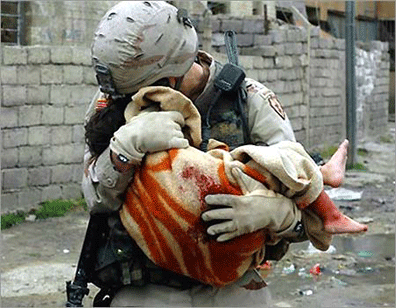
[Note: The following excerpt is from a book review published in the latest New York Review of Books by Michael Massing. The full article is available free online and describes two compelling memoirs of the invasion of Iraq, one by a Marine and one by a reporter embedded with the Marine’s unit. It is well worth reading for a side of the fighting usually sanitized out of reports.]
by Michael Massing, New York Review of Books, December 20, 2007
As the Marines fall back, some are clearly exhilarated at this first exposure to battle; others express remorse. “Before we crossed into Iraq, I fucking hated Arabs,” says Antonio Espera, a thirty-year-old sergeant from California. “I don’t know why…. But as soon as we got here, it’s just gone. I just feel sorry for them. I miss my little girl. Dog, I don’t want to kill nobody’s children.” Coming under heavy fire for the first time, Wright is surprised to find himself calm, but he is astonished at the fierceness of the barrage being directed at Nasiriyah. It includes high-explosive rounds that can blast through steel and concrete as well as DPICMs (Dual-Purpose Improved Conventional Munitions), cluster shells that burst overhead, dispersing dozens of bomblets designed to shred people.
Even in the best of circumstances, Wright notes, artillery fire is imprecise, which leads him to wonder why reporters and antiwar groups concerned about collateral damage in war pay so little attention to it:
The beauty of aircraft, coupled with their high-tech destructive power, captures the imagination. From a news standpoint, jets flying through the sky make for much more dramatic footage than images of cannons parked in the mud, intermittently belching puffs of smoke.
But the fact is, the Marines rely much more on artillery bombardment than on aircraft dropping precision-guided munitions. During our thirty-six hours outside Nasiriyah they have already lobbed an estimated 2,000 rounds into the city. The impact of this shelling on its 400,000 residents must be devastating.
Entering the city with the Marines, Wright gets to see just how devastating the impact has been. Smoke curls from collapsed structures, and houses facing the road are pockmarked and cratered. The corpses of Iraqi attackers are scattered on the road leading out of the city. Run over repeatedly by tracked vehicles, “they are flattened, with their entrails squished out,” Wright notes, adding:
We pass a bus, smashed and burned, with charred human remains sitting upright in some windows. There’s a man in the road with no head and a dead little girl, too, about three or four, lying on her back. She’s wearing a dress and has no legs.
Heading north, the Marines find themselves amid the palm trees and canals of the Fertile Crescent, but all around are signs of death. Along the highway are torched vehicles with “charred corpses nearby, occupants who crawled out and made it a few meters before expiring, with their grasping hands still smoldering.” Lying beside one car is the mangled body of a small child, face down, whose clothes are too ripped to determine the gender. “Seeing this is almost no longer a big deal,” Wright comments. “Since the shooting started in Nasiriyah forty-eight hours ago, firing weapons and seeing dead people has become almost routine.” Fick, reaching back to his four years in a Jesuit high school, writes that he found himself “mouthing the Twenty-third Psalm: ‘Though I walk through the valley of the shadow of death….'”
Further north, as they near the town of Qalat Sukkar, Fick writes, he and his men are ordered to seize a nearby military airfield. This upsets them, since they are not trained for such a mission, and their Humvees lack not only armor but also doors and roofs. Fick is further distressed to hear the new rules of engagement: all personnel on the airfield—whether armed or not—are to be considered hostile. During training, he writes, “we had learned about Vietnam’s free-fire zones. They had been, it was acknowledged, immoral and counterproductive. Qalat Sukkar was being declared a free-fire zone.” As they race toward the airfield, one of his men suddenly opens fire. Looking out, Fick sees in the distance a blur of cars, camels, and men carrying long sticks that might be rifles.
Finally reaching the airfield, the Marines find it deserted. While relieved, they are shaken to see how vulnerable they had been. They are soon approached by five Iraqis dragging two bundles. Inside are two teenaged boys. Both have been wounded—one gravely. Examining him, Doc Bryan, a medic, can see that he’s been shot with 5.56mm rounds, a caliber used by the Americans. “Marines shot this boy!” he roars. It’s now clear that the distant figures who’d been shot at were not fighters with rifles but shepherds with canes…
The morale of Fick’s men continues to erode as they press northward. A new source of tension is added by the need to set up roadblocks to counter the unanticipated threat of suicide attacks. Because these sites tend to be poorly marked, many Iraqi drivers fail to stop at them. When US soldiers fire warning shots, the Iraqis often speed up. As a result, many are killed. After one car has been shot at, a Marine named Graves goes to help a little girl cowering in the back seat, her eyes wide open. As he goes to pick her up, “thinking about what medical supplies he might need to treat her…the top of her head slides off and her brains fall out,” Wright writes. As Graves steps back in horror, his boot slips in the girl’s brains. “This is the event that is going to get to me when I go home,” he says.